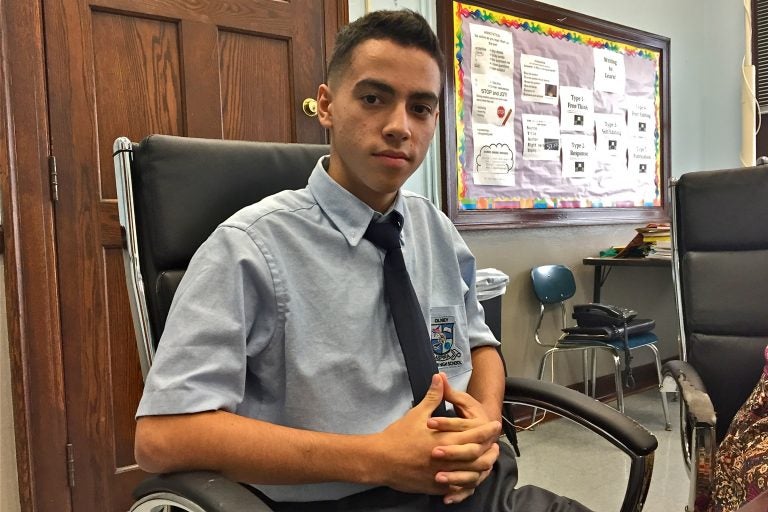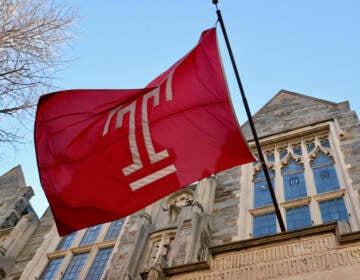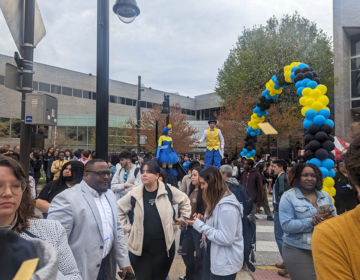In North Philadelphia, a school reshaped by Hurricane Maria
From principal to staff to students, many at Olney Charter High School feel the strain of Maria.

Ninth-grader Carlos Soriano enrolled at Olney Charter High School after leaving Puerto Rico. (Avi Wolfman-Arent/WHYY)
Carlos Soriano was entering his ninth-grade year at a vocational school in northwestern Puerto Rico when Hurricane Maria barreled through the island.
The storm wrecked his hometown of Moca, denuding the lush garden that once wove through his school’s campus. He still thinks about the wreckage of that garden, and the looters who ransacked his town in the aftermath of Maria.
“I feel safer, but still, like, if there’s a little bit of noise, I still wake up,” he said. “And I wake up like three times a night, usually.”
About a month later — with his school still closed — the aspiring architect left his mother in Puerto Rico and moved in with his dad in North Philadelphia.
He enrolled at Olney Charter High School, a school of about 2,000 in the heart of Philadelphia’s Puerto Rican community.
Carlos is one of seven Puerto Rican students displaced by the storm who’ve landed at Olney High. That’s in addition to the 63 students who’ve enrolled at traditional public schools in Philadelphia.
Those aren’t massive numbers in a district of 134,000, where student movement is commonplace.
“It hasn’t been an overwhelming influx,” said district spokesman Lee Whack.
But Olney High’s story since Maria isn’t just about Carlos and other newcomers. The school and its community have been irreparably reshaped by the storm.
Storm’s effects play out 1,500 miles away
There’s the good, such as the student carnival and fundraisers that raised roughly $6,000 for storm relief. On a recent “dress-down” day, students could shed their school uniforms if they gave a dollar to recovery efforts.
And, naturally, there’s the bad, like the trauma inflicted on new students, old students, and staff alike.
Even principal James Thompson’s life has been upended. His elderly father-in-law, who has diabetes, recently left the island to live with him and his wife. Thompson’s father-in-law hopes soon to get a place of his own in Philadelphia. But he does not plan to live in Puerto Rico ever again.
“He said at this point he doesn’t want to deal with that transition,” Thompson said. “He just wants to get settled and live out his time in peace.”
Yemele Ayala’s mother is headed the opposite direction, bound for Puerto Rico next weekend with 200 pounds of supplies she’ll distribute to relatives across the island.
While her mom heads back to Pueto Rico, Ayala, the senior director of student support services, is trying to ease the transition for those young people who’ve already left.
“There’s a lot going on in that mind, in those emotions,” she said.
Ayala once lived those emotions. She was 17 when she left Puerto Rico and enrolled at Temple University. She got her first credit card at the old Strawbridge’s department store and quickly maxed it out buying winter clothing and heavy blankets.
“I remember what I went through,” she said. “I’m used to seeing my colorful houses, and I’m coming here to see brick.”
Ayala and the staff at Olney don’t know if more students displaced by Maria will land at their school. But Pennsylvania will receive more Puerto Rican migrants over the next year than any state besides Florida, according to research out of Hunter College.
But is this the beginning of the wave? The middle? The end?
Olney staff also can’t guess when the students who’ve already arrived might return — if ever. More than half of Puerto Rico’s 1,100 schools are still closed, according to recent reporting from CBS news.
Though Olney is a charter school run by the nonprofit ASPIRA, it functions like a neighborhood high school, taking all students in the surrounding area who want to attend. Nearly two-thirds of the school’s students are Hispanic, and nearly 600 are English language learners, said Beth Logue, who runs Olney’s ELL program.
That’s been a comfort to some of the students who’ve arrived recently from Puerto Rico.
Some sounds of home
“When I get a new student, I say there are many, many students here from Puerto Rico and Dominican Republic and many Spanish-speaking students,” Logue said. “You will have many friends here. Muchas amigas y amigos.”
With its ELL population exploding, however, Olney has struggled to find enough bilingual teachers for its many Spanish speakers. The school has always recruited in Puerto Rico, a traditional wellspring of bilingualism. Olney plans now to double its efforts after the storm, figuring many Puerto Rican teachers will no longer have jobs on the island.
“It’s hard to find bilingual teachers certified at the high school level,” said Logue. “So that’s a really important need of ours right now.”
Those teachers will work with Carlos Soriano and other students who are trying to find their way at Olney.
Carlos likes the students and teachers so far at Olney, but misses the sprawling, tropical landscape at his old school. He feels “cooped up” inside Olney High, a hulking, Gothic Revival structure built before the Great Depression.
Carlos’ dad and his brothers warned him that school would be harder in Philadelphia than it was in Puerto Rico, but Carlos is focused. He wants to stay on track so someday he can return to Moca.
His old school had an architecture program that led to certification, but Carlos doesn’t know if he’ll be able to continue those pursuits in Philadelphia.
“I don’t know any universities … so I don’t know really how to become an architect here,” he said.
But Carlos is one of the lucky ones. He speaks English well and had a solid education back in Puerto Rico. His greatest hurdles may be the separation from his mom and the creeping chill of winter, a season he’s never experienced up north.
“I’m like it’s really cold, and my brother say that’s nothing,” Carlos said
• • •
The School District of Philadelphia has received 63 students so far from Puerto Rico who were directly displaced by Hurricane Maria. Officials say the number could be higher because not all students self-identify as hurricane evacuees. The following schools have received displaced students from Puerto Rico. The majority are in North and Northeast Philadelphia
SCHOOLS
George Washington High School
Thomas Edison High School
Penn Treaty High School
Frances Willard
Samuel Fels High School
Juniata Park Academy
Olney School (Elementary)
Bayard Taylor
Northeast High School
Stephen Decatur
Allen Stearne
Kensington High School for Creative and Performing Arts
John Welsh
Thomas Potter
Cayuga
William McKinley
John Hartranft
Kensington Health Sciences Academy
Phillip Sheridan
William Ziegler
Kensington High School
WHYY is your source for fact-based, in-depth journalism and information. As a nonprofit organization, we rely on financial support from readers like you. Please give today.





